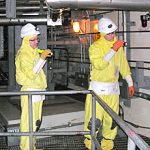Last Updated on May 22, 2024 by Ali Hamza
Explore Ultrasonic Testing for internal flaws, Radiographic Testing for internal structure examination, Eddy Current Testing for electromagnetic field interactions, Magnetic Particle Inspection for surface flaws, and Liquid Penetrant Inspection for meticulous defect detection. Understand the importance of safety precautions, film interpretation, precise application techniques, and sensitivity settings in flaw identification. Discover the applications in various industries and the nuances of each NDT method for comprehensive understanding. Gain insights into the critical aspects of non-destructive testing through an in-depth exploration of these advanced techniques.
Key Takeaways
– Ultrasonic Testing detects internal flaws with high-frequency sound waves.
– Radiographic Testing examines internal structures with electromagnetic radiation.
– Eddy Current Testing relies on electromagnetic field interactions for flaw detection.
– Magnetic Particle Inspection detects surface flaws in ferromagnetic materials.
– Liquid Penetrant Inspection uses precise techniques to identify defects accurately.
Ultrasonic Testing
When conducting Ultrasonic Testing, professionals utilize high-frequency sound waves to detect internal flaws in materials. Ultrasonic flaw detection is a critical aspect of this non-destructive testing method, allowing for the identification of cracks, voids, and other imperfections that may compromise the integrity of a material. By emitting these sound waves into the material being tested and analyzing the echoes that bounce back, technicians can pinpoint the location and size of any potential flaws present.
Additionally, Ultrasonic Testing is highly effective in thickness measurement techniques. By assessing the time it takes for sound waves to travel through a material and return, professionals can accurately determine the thickness of the material under inspection. This information is vital in ensuring the structural integrity of components in various industries, such as manufacturing, aerospace, and construction.
Radiographic Testing
Radiographic Testing is a technique that employs electromagnetic radiation to examine the internal structure of materials for flaws and defects. This method is commonly used in industries such as aerospace, construction, and manufacturing to ensure the integrity of critical components. When conducting Radiographic Testing, safety precautions are paramount to protect personnel from radiation exposure. Proper shielding, monitoring equipment, and restricted access areas are essential elements to maintain a safe testing environment.
Film interpretation plays a crucial role in Radiographic Testing. Skilled technicians analyze the developed radiographic films to identify and evaluate any indications of defects within the material being inspected. This process requires precision and attention to detail to accurately interpret the radiographic images.
Eddy Current Testing
When considering Eddy Current Testing, you’ll explore its principle of operation, applications, and limitations. Understanding how this technique works, its various uses, and the constraints it may have in certain scenarios is crucial for NDT professionals.
Principle of Operation
To understand the Principle of Operation for Eddy Current Testing, one must delve into the electromagnetic field interactions within the testing material. This NDT technique relies on inducing eddy currents in a conductive material using a coil carrying an alternating current.
The eddy currents generate their own magnetic field, interacting with the coil’s magnetic field. Any defects or variations in the material cause disruptions in the eddy current flow, altering the impedance in the coil.
Applications and Limitations
In assessing the suitability of Eddy Current Testing for a specific application, it’s crucial to consider both its strengths and limitations.
Eddy Current Testing finds applications in various industries like aerospace, automotive, and electrical, for flaw detection, conductivity measurements, and heat treatment monitoring. Its non-destructive nature and ability to inspect complex shapes make it a valuable tool.
However, challenges exist, such as limited penetration depth in ferromagnetic materials, surface finish requirements, and the need for highly skilled operators. These limitations may affect the accuracy and reliability of the inspection results.
Understanding these applications and challenges is essential for effectively utilizing Eddy Current Testing and maximizing its benefits while mitigating its limitations in NDT practices.
Magnetic Particle Inspection
Magnetic Particle Inspection detects surface and near-surface flaws in ferromagnetic materials by applying magnetic fields and iron particles. To ensure accurate results, proper surface preparation is crucial, as any contaminants or coatings can hinder flaw detection. The magnetic field is carefully applied, and iron particles are then dispersed over the material being inspected. The particles will be attracted to areas where a magnetic flux leakage occurs, indicating a flaw.
When conducting Magnetic Particle Inspection, sensitivity settings play a vital role in determining the size of flaws that can be detected. Adjusting the sensitivity settings allows for customization based on the material and the type of flaw being searched for. Additionally, the selection of iron particles is essential. Different particle sizes and colors are available, each with its own advantages depending on the application.
Liquid Penetrant Inspection
When conducting Liquid Penetrant Inspection, remember to carefully apply the penetrant using specific techniques. Follow the step-by-step inspection process meticulously to ensure thorough coverage and accurate results.
Lastly, pay close attention to interpreting the results to identify any defects or irregularities accurately.
Penetrant Application Techniques
Utilize precise and controlled techniques for the application of penetrant in liquid penetrant inspection to ensure thorough coverage and accurate defect detection.
Before applying the penetrant, ensure proper surface preparation, free of any contaminants that could interfere with the inspection process. Adhere strictly to inspection standards to maintain consistency and reliability in the results.
When applying the penetrant, make sure to follow a systematic approach, covering the entire surface methodically. Apply the penetrant evenly, allowing ample time for it to seep into any potential defects. Avoid excessive application that could lead to overloading and subsequent false indications.
Inspection Process Steps
Begin the inspection process in liquid penetrant inspection by thoroughly cleaning the surface to ensure proper adhesion and penetration of the penetrant. Once clean, follow these steps:
– Apply the penetrant solution evenly across the surface.
– Allow sufficient dwell time for the penetrant to seep into any surface defects.
– Carefully remove excess penetrant from the surface without disturbing the penetrated areas.
These inspection techniques are crucial in liquid penetrant inspection to ensure accurate results. Quality control processes should be rigorously followed to maintain high standards throughout the inspection. By adhering to these steps, you can enhance the effectiveness of the inspection process and detect any defects with precision.
Interpretation of Results
To accurately interpret results in liquid penetrant inspection, carefully analyze the indications revealed on the surface after the inspection process. Through statistical analysis and data interpretation, you can gain valuable insights into the condition of the material being inspected.
Look for patterns, sizes, shapes, and locations of indications to determine the significance of each flaw. By comparing these indications against established acceptance criteria, you can make informed decisions regarding the integrity of the part.
Pay close attention to any trends that may emerge during the analysis, as they could provide crucial information about the overall quality of the component. Remember, thorough and systematic interpretation is key to ensuring the reliability of your inspection results.
Visual Testing
When conducting visual testing in non-destructive testing (NDT), your keen observation skills play a crucial role in detecting surface imperfections. Visual testing techniques involve the use of advanced equipment to aid in surface inspection and weld analysis.
Here are key points to consider:
– Techniques: Utilize various methods such as direct visual inspection, remote visual inspection, and videoscopes to thoroughly examine components.
– Equipment: Employ tools like borescopes, magnifying glasses, and cameras fitted with macro lenses for detailed assessments.
– Analysis: Pay attention to weld bead profiles, surface discontinuities, and any irregularities that may indicate defects.
Acoustic Emission Testing
How can Acoustic Emission Testing enhance your non-destructive testing capabilities?
Acoustic Emission Testing is a powerful method that can provide valuable insights into the structural integrity of materials. By detecting and analyzing acoustic signals emitted by materials under stress, this technique enables you to identify potential defects or flaws before they lead to catastrophic failures. Through advanced signal analysis, Acoustic Emission Testing can pinpoint the exact location and severity of defects, allowing for targeted repairs and maintenance.
Moreover, Acoustic Emission Testing is particularly beneficial for structural monitoring. By continuously monitoring acoustic emissions during the operation of a structure, you can assess its ongoing health and detect any changes that may indicate imminent issues. This proactive approach to maintenance can help prevent costly downtime and ensure the safety and reliability of critical infrastructure.
Infrared Testing
When conducting Infrared Testing, you can pinpoint temperature variations that may indicate structural issues, making it a valuable tool for preventive maintenance.
This method is commonly used in NDT for its ability to detect defects in various materials, including composites and metals.
Benefits of Infrared Testing
Infrared testing offers professionals a non-destructive method to detect and analyze thermal anomalies in various materials and structures. This method provides several benefits:
– Identification of Thermal Anomalies: Infrared testing allows you to identify areas of concern such as heat loss, moisture intrusion, or electrical faults by detecting temperature variations.
– Enhanced Equipment Calibration: By utilizing infrared testing, professionals can calibrate equipment accurately, ensuring that measurements are precise and reliable.
– Early Issue Detection: With the ability to detect thermal irregularities early on, professionals can address potential problems before they escalate, saving time and resources.
These benefits make infrared testing a valuable tool for maintaining the integrity and safety of materials and structures.
Applications in NDT
Applications of NDT, specifically in the realm of infrared testing, encompass a wide range of industries and inspection scenarios. Infrared testing is invaluable for corrosion detection, allowing for non-intrusive assessment of structures for potential corrosion issues. This method is particularly useful in industries such as oil and gas, where pipelines are prone to corrosion.
Moreover, infrared testing is crucial for ensuring weld integrity in various applications. By detecting irregularities in the heat distribution of welds, this technique helps prevent structural failures and ensures the overall safety and reliability of welded components.
From assessing building envelopes for energy efficiency to monitoring electrical systems for overheating, the applications of infrared testing in NDT are diverse and essential across multiple sectors.
Electromagnetic Testing
Electromagnetic Testing is a non-destructive method used to detect imperfections in materials through the application of electromagnetic fields. This technique is valuable for evaluating the structural integrity of various components.
Here are key points to consider:
– Signal Interpretation: Understanding the signals obtained from electromagnetic testing is crucial. Different signal patterns can indicate various flaws or material properties. Interpretation skills are essential for accurate assessment.
– Material Properties: The electromagnetic field interacts differently with materials based on their properties. Variances in conductivity, permeability, and other characteristics influence how defects are detected. Knowledge of these material properties enhances the effectiveness of electromagnetic testing.
– Equipment Utilization: Utilizing the right electromagnetic testing equipment is vital for obtaining reliable results. Proper calibration and adherence to testing protocols are necessary for successful inspections.
Mastering electromagnetic testing requires a deep understanding of signal interpretation, material properties, and precise equipment utilization. By honing these skills, you can proficiently assess materials for flaws and ensure structural reliability.
Neutron Radiographic Testing
To effectively assess materials for flaws and ensure structural reliability, professionals often employ Neutron Radiographic Testing as a non-destructive method. Neutron radiographic advancements have significantly enhanced the capabilities of this technique, allowing for improved imaging quality and the detection of smaller defects within materials. This method finds extensive industrial applications in sectors such as aerospace, defense, and automotive industries, where precision and reliability are paramount.
When conducting Neutron Radiographic Testing, it’s crucial to adhere to strict safety precautions to protect personnel from radiation exposure. Shielding and monitoring devices must be utilized to minimize potential risks. Additionally, considering the environmental impact of this technique is essential. Proper disposal methods for radioactive materials and the management of any waste generated during testing are vital to prevent harm to the environment.
Microwave Testing
Have you ever considered the effectiveness of Microwave Testing in non-destructive evaluation processes for materials? Microwave Testing is a valuable method that involves utilizing microwave absorption and reflection testing techniques to assess materials without causing damage.
Here are some key points to understand about Microwave Testing:
– Microwave Absorption: This method involves directing microwave energy towards the material being tested. The material’s response to the microwave energy provides valuable insights into its internal structure and potential defects.
– Reflection Testing: By analyzing the reflection of microwave signals from the material’s surface, technicians can identify inconsistencies or irregularities within the material without the need for physical alterations.
– Non-Destructive Evaluation: Microwave Testing offers a non-invasive way to examine materials, making it a preferred choice in industries where preserving the integrity of the tested objects is crucial.
Incorporating Microwave Testing into your non-destructive evaluation processes can enhance the accuracy and efficiency of material assessments, leading to improved quality control and safety measures.
Laser Testing
When exploring non-destructive evaluation processes for materials, Laser Testing emerges as a cutting-edge technique that offers precise and efficient assessment capabilities. Laser Testing utilizes high-powered lasers to inspect materials for defects, measure thickness, and assess structural integrity without causing damage. In industries like manufacturing and aerospace, Laser Testing plays a crucial role in ensuring the quality and safety of components.
One significant application of Laser Testing is in laser welding. This process involves using a laser beam to join materials together with high precision, producing strong and reliable welds. Laser welding is favored for its speed and accuracy, making it a popular choice in industries where efficiency is paramount.
Another essential aspect of Laser Testing is laser cutting. Laser cutting utilizes a focused laser beam to precisely cut through materials with exceptional detail and minimal heat-affected zones. This method is widely used in various industries for its ability to produce clean and accurate cuts on a wide range of materials.
Conclusion
In conclusion, the various types of NDT discussed in this exploration offer professionals a wide range of tools to effectively and accurately test materials and components for defects.
From Ultrasonic Testing to Laser Testing, each method has its own unique advantages and applications.
Understanding the differences and benefits of each technique is essential for ensuring the quality and reliability of industrial products.
Keep exploring and honing your skills in NDT to excel in your field.























